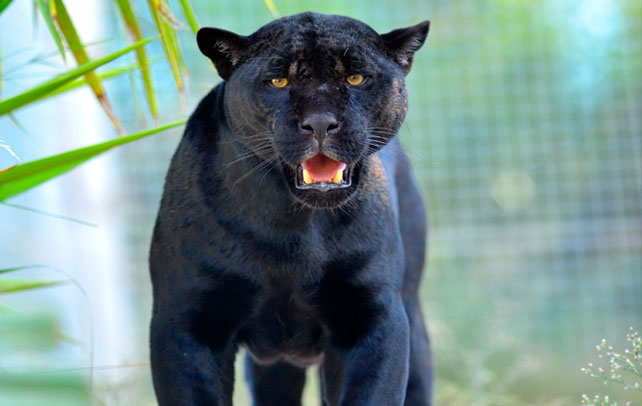Amazing Facts About Black Panther

The panther (also known as black panther), the malanistic version of species of larger cats, is known by different names at different places. In Latin America, it is known as jaguar; leopard is the name given in Asia and Africa; and in North America, it is called as cougar or panther. Panthers are very scary and with black body and yellow eyes, they become even more frightening. The cubs of panther can be black or fair with spots. Tree is their second home and they often hunt from trees. They hide in the branches of trees and pounce on the prey from there, almost stunning the prey. They attack the prey’s neck so as to stop their nasal cavity and finally choking them to death. They store the hunted food in trees in order to hide it food from scavengers. They can be mostly found in Nepal, Assam, Malay Peninsula, Myanmar, and China. It is believed that some species of panther also exist in United Kingdom and America. Read the next section to collect some more interesting and amazing facts about the panther.
Fast Facts
Scientific Name: Panthera Pardus
Kingdom: Animalia
Phylum: Chordata
Class: Mammalia
Order: Carnivora
Family: Felidae
Subfamily: Felinae
Species: Pardus (leopard)/ Onca (jaguar)/ leo (lion)/ Tigris (tiger)
Shape: Big cats
Diet: Carnivore
Size: Body: 4.25 to 6.25ft; Tail: 3.5 to 4.4ft
Weight: 29 to 91kg
Teeth: 32
Life Span: 20 years under supervision and 12 years on their own
Natural Habitat: Rainforest, woodlands, marshland, swamps, deserts and mountains
Call: Roar, growl, snarl
Gestation Period: 3 to 4 months
Number of Offspring: 2 to 4 cubs
Interesting And Fun Facts About Black Panther
- Panthers have a dark black body but from a close distance you can see leopard prints or spots on their body. Therefore, spots or prints, the main feature of panthers’ body is not lost in their mutation.
- Panthers are great swimmers and often dive to relax themselves.
- They have keen sense of hearing and extremely good eye sight with strong jaws and firm claws to hold on their prey.
- They are very agile and can leap up to 20 feet to catch their food. Medium sized animals, like deer, antelopes, monkeys; and small animals, like rabbits and birds are the main source of their food.
- It is the fifth largest species of cat as it has a very large skull and long body, but its legs are short. Their large skull makes for a very strong jaw, with which they can even attack and kill a giraffe.
- They are very good and strong climbers and can take their heavy prey on trees and devour the food there.
- Their speed is up to 58 kilometres per hour and they can run after their prey with the same speed.
- They love to stay alone but come close for mating. The she-panther stays with the cubs till they are one and an half years old or till they learn the skills to hunt.
- Panther cubs are blind and their eyes are closed and covered with slightly grey fur when they are born. They don’t open their eyes until they are nearly two weeks old.
- Black jaguars may give birth to either complete black or spotted cubs, but a pair of spotted jaguars can produce spotted cubs only.
- The black jaglion female and the tanned spotted jaglion male were produced in the bear creek wildlife sanctuary, Canada, by inadvertently crossing a lioness named Lola with the lion named Diablo.
- Usually cubs are very fast learners and they are able to catch small preys by the age of six to nine months and they become expert in catching a bigger prey at the age of two years.
- It has been believed that black leopards are rejected by their mothers at the time of birth due to their colour. But actually, poor temperament, as a side-effect of inbreeding, is the main reason for this behaviour.
- The colour of their skin helps them in camouflaging at night and catching a prey.
- The black leopard differs completely from the snow leopard, found in Himalayas of India. They have albinism which reduces pigmentation as opposed to melanism in black panthers.
- Pseudo-melanism—the effect of having more generous markings as compared to the normal ones—occurs in black panthers. The brown spots on the body of a pseudo-melanic black panther are more densely packed as compared to the normal black background and therefore, the colour of its body appears golden brown.
- Black cougars, the truly black variant of big cats, have never been seen or photographed. There is a controversy on whether they exist or not.
- In the year 1980, a 10 year black panther, acquired by the Glasgow zoo in Switzerland, was found to be suffering with vitiligo. The panther had white coloured hair on his black body and the pattern appeared like spider webs; this is the reason why this panther was named as cobweb panther. Since then, many cobweb panthers have been reported.
- Black panthers were used as mascots by the United States soldiers, re-stationed in Australia, at the end of World War II, but these panthers supposedly escaped from the territories.
- Australian panthers, one of the species of black panthers, are responsible for the disappearance of cats, dogs, and livestock in rural Victoria, New South Wales, and Western Australia.
- Black panthers can adapt to any climatic condition and survive both cold and warm environment. This is the reason why they have been able to survive even after the endangerment of their habitats by rapid deforestation and extreme hunting.









